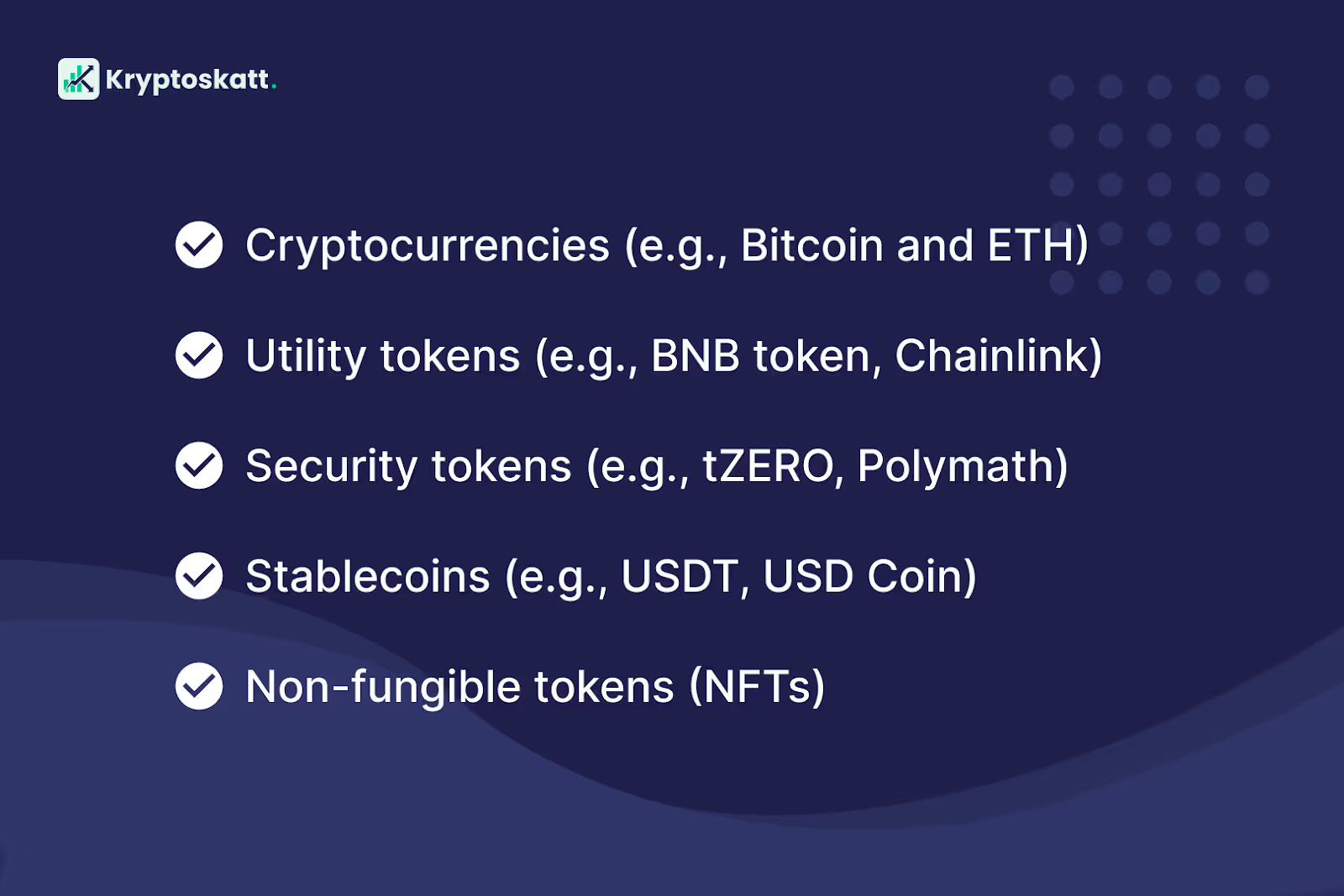.avif)
Calculate Your Crypto
Taxes in Minutes

With over 22,932 cryptocurrencies and multiple asset classes, how you are managing your crypto portfolio is crucial for maximum ROI. But unfortunately, many investors ignore this step, preventing them from reaping maximum returns from their assets.
A healthy portfolio ensures your funds are preserved and you can remain invested in the long run. And this applies to both beginners and pro-investor.
In this guide, we’ve covered everything to get you started with your crypto portfolio management and also discussed how to leverage crypto accounting for managing your portfolio effectively.
What Is Crypto Portfolio Management?
Crypto portfolio management is the process of evaluating and calibrating your cryptocurrency investments, aiming to maximize returns while mitigating risk.
This includes understanding crypto asset classes, selecting the right management style, monitoring market trends, and using appropriate tools to maintain a well-balanced and diversified portfolio.
What Are The Different Types Of Crypto Asset Classes?
To manage your crypto portfolio effectively, it's essential to understand the different types of crypto assets available.
The most common asset classes include:

Each asset class comes with unique features, risks, and potential rewards. This makes it crucial to diversify your investments across various classes to minimize risk and maximize returns.
Styles of Crypto Portfolio Management
Depending on your financial goals and risk tolerance, you may manage your crypto portfolio using either of the following two styles: Active or Passive.
Let’s look at each of them in detail.
Active Crypto Portfolio Management
This approach involves continuously monitoring market trends, conducting research, and making frequent trades to capitalize on price fluctuations.
Active managers seek to outperform the market by leveraging short-term trends and adjusting the portfolio for maximum returns. This is a high-risk, high-reward approach as your profits are based on volatile prices which may change in either direction frequently.
Passive Crypto Portfolio Management
Investors following this strategy tend to hold long-term positions in a diversified portfolio. Here, you aim to achieve market returns by minimizing the trading frequency and associated costs.
Instead of trading frequently, you focus on acquiring crypto assets that show promising growth in the long run. This option is better if you are new to the crypto trading space or don’t want to actively manage your portfolio yet gain profits.
How To Manage Your Crypto Portfolio Like A Pro?
Before you get started with your crypto portfolio management, consider the following steps:

Now, here are 5 tips to manage your crypto portfolio like a pro:
Maintain Accurate Records of Your Investments
Tracking your investments allows you to monitor the performance of different assets and your overall portfolio. This information is vital to assess if your investments are meeting your financial goals or if any adjustments are required.
It also ensures that you report your crypto activity correctly and avoid potential penalties from tax authorities.
Keep accurate records of your investments using the following steps:
- Use a crypto accounting tool to track your crypto investments from multiple exchanges.
- Regularly update any new transactions. You can also use an app like Kryptos to auto-sync all your crypto transactions in one place.
Diversify Your Crypto Portfolio
Diversification is a key strategy for managing risk and enhancing the potential for returns in your crypto portfolio.
The logic is simple: by investing in a variety of asset classes, you spread the risk across multiple investments, reducing the impact of underperformance in any single asset.
For example, imagine you have invested solely in Solana (SOL), and its value takes a sudden plunge due to unfavourable market conditions. Your entire portfolio would suffer a significant loss.
However, if you had diversified your investments across various cryptocurrencies and other asset classes, such as stablecoins, the negative impact on your overall portfolio would be lessened. This is because the other assets might perform well or remain stable, even when SOL’s value declines.
Monitor Market Trends
This knowledge enables you to make strategic decisions about your investments, ensuring your portfolio remains agile and competitive.
To stay up to date in the crypto space, you can subscribe to popular crypto news outlets or join online communities. This is especially beneficial if you are trading and managing your crypto portfolio actively.
Make Changes & Keep an Exit Strategy
The future of your investments is not certain. Be prepared to make changes based on market conditions, new information, or shifting investment goals.
For instance, if you learn about an upcoming development in a particular cryptocurrency, you may want to adjust your holdings accordingly.
You must also be clear about when you want to exit and take your profit or cut losses. This helps you manage your expectations and saves you from impulsive decisions.
Use Portfolio Tracking and Analysis Tools
Choosing the right tools can make managing your crypto portfolio seamless. Imagine having a virtual assistant that keeps all your crypto data organized, making it easier to stay on top of your investments and make informed decisions.
Some software also calculates the tax implications of your crypto assets to help you stay legally compliant while enjoying maximum profits.
When selecting a management tool, consider one with the following capabilities:
- Accurate, real-time data and analytics: Choose a portfolio tracking software that keeps all your investment information up-to-date to make well-informed decisions.
- Integration with multiple exchanges: Having a tool that consolidates data from various exchanges provides a holistic view of your investments, making it easier to manage your portfolio effectively.
- Comprehensive tracking of your portfolio's performance: A regularly updated portfolio will enable you to quickly identify trends and areas for improvement.
- Streamlined tax reporting and compliance features: A good portfolio management tool simplifies crypto taxes, ensuring you meet all regulatory obligations.
The Best Crypto Portfolio Management App
A powerful crypto portfolio management app can make your life as an investor a lot easier – from managing all your assets in one place to finding its tax implications and maximizing savings.
The easiest way to start is to use Kryptos, a cutting-edge crypto portfolio management app designed to simplify the entire process for investors. Its intuitive interface, robust analytics, and wide range of integrations make it an ideal choice for both active and passive investors.
All you have to do is add your wallet to the app, and it auto-syncs real-time data of all your assets for you.
You can easily manage your portfolio including NFTs and DeFi from their dashboard and calculate your capital gains, claim losses, and know your tax liability. To get started, Sign Up Now.
FAQs
1. What role does crypto accounting play in risk management for crypto portfolios?
Crypto accounting provides investors with accurate, up-to-date information about their investments. By tracking and analyzing these transactions, and their tax implications, investors can identify potential risks, assess their exposure, and make informed decisions to rebalance their portfolios and mitigate risk.
2. What is the role of crypto accounting in Portfolio Management?
Crypto accounting helps investors track, analyze, and optimize their cryptocurrency investments. With accurate data on transactions, performance, and tax implications, investors can make well-informed decisions, adjust their portfolios as needed, and ensure compliance with tax regulations.
3. What is a Cryptocurrency Portfolio?
A cryptocurrency portfolio is a collection of various crypto assets, including cryptocurrencies, utility tokens, security tokens, stablecoins, and non-fungible tokens (NFTs), owned by an individual or organization. A well-managed crypto portfolio aims to achieve specific financial goals while minimizing risk through diversification and strategic investment decisions.
4. What is Portfolio Management?
Portfolio management is the process of selecting, monitoring, and optimizing a collection of investments to achieve financial objectives while managing risk. This involves understanding asset classes, selecting appropriate management styles, monitoring market trends, and utilizing effective tools to maintain a well-balanced and diversified portfolio.
5. How does crypto accounting impact traditional portfolio management practices?
Investors must track and account for transactions, tax implications, and the performance of various crypto assets while dealing with the volatile crypto market. By incorporating crypto accounting into their portfolio management, investors can optimize this process, make informed decisions, and ensure tax compliance.
All content on Kryptos serves general informational purposes only. It's not intended to replace any professional advice from licensed accountants, attorneys, or certified financial and tax professionals. The information is completed to the best of our knowledge and we at Kryptos do not claim either correctness or accuracy of the same. Before taking any tax position / stance, you should always consider seeking independent legal, financial, taxation or other advice from the professionals. Kryptos is not liable for any loss caused from the use of, or by placing reliance on, the information on this website. Kryptos disclaims any responsibility for the accuracy or adequacy of any positions taken by you in your tax returns. Thank you for being part of our community, and we're excited to continue guiding you on your crypto journey!
| Step | Form | Purpose | Action |
|---|---|---|---|
| 1 | 1099-DA | Reports digital asset sales or exchanges | Use to fill out Form 8949. |
| 2 | Form 1099-MISC | Reports miscellaneous crypto income | Use to fill out Schedule 1 or C. |
| 3 | Form 8949 | Details individual transactions | List each transaction here. |
| 4 | Schedule D | Summarizes capital gains/losses | Transfer totals from Form 8949. |
| 5 | Schedule 1 | Reports miscellaneous income | Include miscellaneous income (if not self-employment). |
| 6 | Schedule C | Reports self-employment income | Include self-employment income and expenses. |
| 7 | Form W-2 | Reports wages (if paid in Bitcoin) | Include wages in total income. |
| 8 | Form 1040 | Primary tax return | Summarize all income, deductions, and tax owed. |
| Date | Event/Requirement |
|---|---|
| January 1, 2025 | Brokers begin tracking and reporting digital asset transactions. |
| February 2026 | Brokers issue Form 1099-DA for the 2025 tax year to taxpayers. |
| April 15, 2026 | Deadline for taxpayers to file their 2025 tax returns with IRS data. |
| Timeline Event | Description |
|---|---|
| Before January 1, 2025 | Taxpayers must identify wallets and accounts containing digital assets and document unused basis. |
| January 1, 2025 | Snapshot date for confirming remaining digital assets in wallets and accounts. |
| March 2025 | Brokers begin issuing Form 1099-DA, reflecting a wallet-specific basis. |
| Before Filing 2025 Tax Returns | Taxpayers must finalize their Safe Harbor Allocation to ensure compliance and avoid penalties. |
| Feature | Use Case Scenario | Technical Details |
|---|---|---|
| Automated Monitoring of Transactions | Alice uses staking on Ethereum 2.0 and yield farming on Uniswap. Kryptos automates tracking of her staking rewards and LP tokens across platforms. | Integrates with Ethereum and Uniswap APIs for real-time tracking and monitoring of transactions. |
| Comprehensive Data Collection | Bob switches between liquidity pools and staking protocols. Kryptos aggregates all transactions, including historical data. | Pulls and consolidates data from multiple sources and supports historical data imports. |
| Advanced Tax Categorization | Carol earns from staking Polkadot and yield farming on Aave. Kryptos categorizes her rewards as ordinary income and investment income. | Uses jurisdiction-specific rules to categorize rewards and guarantee compliance with local tax regulations. |
| Dynamic FMV Calculation | Dave redeems LP tokens for Ethereum and stablecoins. Kryptos calculates the fair market value (FMV) at redemption and during sales. | Updates FMV based on market data and accurately calculates capital gains for transactions. |
| Handling Complex DeFi Transactions | Eve engages in multi-step DeFi transactions. Kryptos tracks value changes and tax implications throughout these processes. | Manages multi-step transactions, including swaps and staking, for comprehensive tax reporting. |
| Real-Time Alerts and Updates | Frank receives alerts on contemporary tax regulations affecting DeFi. Kryptos keeps him updated on relevant changes in tax laws. | Observe regulatory updates and provide real-time alerts about changes in tax regulations. |
| Seamless Tax Reporting Integration | Grace files taxes using TurboTax. Kryptos integrates with TurboTax to import staking and yield farming data easily. | Direct integration with tax software like TurboTax for smooth data import and multi-jurisdictional reporting. |
| Investor Type | Impact of Crypto Tax Updates 2025 |
|---|---|
| Retail Investors | Standardized crypto reporting regulations make tax filing easier, but increased IRS visibility raises the risk of audits. |
| Traders & HFT Users | To ensure crypto tax compliance, the IRS is increasing its scrutiny and requiring precise cost-basis calculations across several exchanges. |
| Defi & Staking Participants | The regulations for reporting crypto transactions for staking rewards, lending, and governance tokens are unclear, and there is a lack of standardization for decentralized platforms. |
| NFT Creators & Buyers | Confusion over crypto capital gains tax in 2025, including the taxation of NFT flips, royalties, and transactions across several blockchains. |
| Crypto Payments & Businesses | Merchants who take Bitcoin, USDC, and other digital assets must track crypto capital gains for each transaction, which increases crypto tax compliance requirements. |
| Event | Consequences | Penalties |
|---|---|---|
| Reporting Failure | The tax authorities can mark uncontrolled revenues and further investigate. | Penalty fines, interest on unpaid taxes and potential fraud fees if they are deliberately occurring. |
| Misreporting CGT | Misreporting CGT Error reporting profits or losses can trigger the IRS audit. | 20% fine on under -ported zodiac signs, as well as tax and interest. |
| Using decentralized exchanges (DEXs) or mixers without records | The IRS can track anonymous transactions and demand documentation. | Possible tax evasion fee and significant fine. |
| Disregarding Bitcoin mining tax liabilities | Mining reward is considered taxable income, and failure of the report can be regarded as tax fraud. | Further tax obligations, punishment and potential legal steps. |
| Foreign crypto holdings: Non-disclosure | Foreign-accepted crypto FATCA may be subject to reporting rules. | Heavy fines (up to $ 10,000 per fracture) or prosecution for intentional non-transport. |
File Your Crypto Tax in Minutes







.avif)
